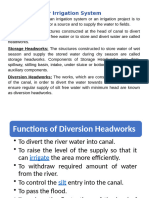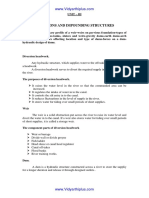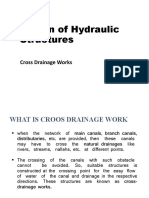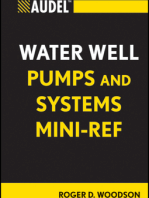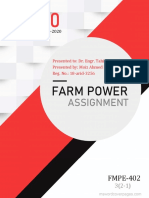0 ratings0% found this document useful (0 votes)
53 viewsChapter - 09
Chapter - 09
Uploaded by
Moiz Khan YousufzaiThis document outlines the course contents for the design of hydraulic structures. It covers topics like diversion head-works, theory and design of canal regulation structures, cross drainage works, highway crossings, spillways and special topics. The assessment criteria includes theory exams, practical assignments, projects and presentations. Key components of diversion weirs and barrages are described along with principles of silt control at head works using methods like still pond control, semi-open flow operation, silt excluders and silt ejectors. Design details of silt excluders are also provided.
Copyright:
© All Rights Reserved
Available Formats
Download as PPTX, PDF, TXT or read online from Scribd
Chapter - 09
Chapter - 09
Uploaded by
Moiz Khan Yousufzai0 ratings0% found this document useful (0 votes)
53 views30 pagesThis document outlines the course contents for the design of hydraulic structures. It covers topics like diversion head-works, theory and design of canal regulation structures, cross drainage works, highway crossings, spillways and special topics. The assessment criteria includes theory exams, practical assignments, projects and presentations. Key components of diversion weirs and barrages are described along with principles of silt control at head works using methods like still pond control, semi-open flow operation, silt excluders and silt ejectors. Design details of silt excluders are also provided.
Original Title
Chapter - 09.pptx
Copyright
© © All Rights Reserved
Available Formats
PPTX, PDF, TXT or read online from Scribd
Share this document
Did you find this document useful?
Is this content inappropriate?
This document outlines the course contents for the design of hydraulic structures. It covers topics like diversion head-works, theory and design of canal regulation structures, cross drainage works, highway crossings, spillways and special topics. The assessment criteria includes theory exams, practical assignments, projects and presentations. Key components of diversion weirs and barrages are described along with principles of silt control at head works using methods like still pond control, semi-open flow operation, silt excluders and silt ejectors. Design details of silt excluders are also provided.
Copyright:
© All Rights Reserved
Available Formats
Download as PPTX, PDF, TXT or read online from Scribd
Download as pptx, pdf, or txt
0 ratings0% found this document useful (0 votes)
53 views30 pagesChapter - 09
Chapter - 09
Uploaded by
Moiz Khan YousufzaiThis document outlines the course contents for the design of hydraulic structures. It covers topics like diversion head-works, theory and design of canal regulation structures, cross drainage works, highway crossings, spillways and special topics. The assessment criteria includes theory exams, practical assignments, projects and presentations. Key components of diversion weirs and barrages are described along with principles of silt control at head works using methods like still pond control, semi-open flow operation, silt excluders and silt ejectors. Design details of silt excluders are also provided.
Copyright:
© All Rights Reserved
Available Formats
Download as PPTX, PDF, TXT or read online from Scribd
Download as pptx, pdf, or txt
You are on page 1of 30
Chapter 9
DESIGN OF HYDRAULIC STRUCTURES
COURSE CONTENTS
Diversion Head-Works
Introduction to Seepage Theories
Introduction to Diversion Head-Works
Barrage Regulation & Silt Control Devices
Design of Modern Weirs and Barrages on Permeable Foundation
Theory and Design of Canal Regulation Structures
Head Regulators
Cross Regulators
Canal Escapes
Canal Falls/Drop Structures
Cross Drainage Works
Super Passage
Aquaduct
Syphon Aquaduct
Level Crossing
COURSE CONTENTS
Highway Crossings
Culverts
Design of Parameters
Characteristics of Flow
Methods of Culvert Design
Performance Curves
Bridges
Spillways
Types of Spillways
Hydraulic Design of Over flow and Ogee Spillways
Energy Dissipation below the Spillways
Design of Stilling Basin
Special Topics
REFERENCE BOOKS
Hydraulic Structure’s Hand Book by Larry May
Hydraulic Structures by P. Novak
Hydraulic Structure by Davis
Irrigation Engineering & Hydraulic Structures by S.K. Garg
ASSESSMENT CRITERIA
Theory 100 Marks
Final Exam 50 Marks
Mid-term 30 Marks
Quizzes 20 Marks
Practical 100 Marks
Project+Presentation 40 Marks
Assignments 30 Marks
Class Performance 10 Marks
Viva 20 Marks
DIVERSION HEAD WORKS
Diversion Head Works
The diversion head works are constructed at the head of the canal to divert
the river water towards the canal, so as to ensure a regulated continuous
supply of silt-free water into the canal.
Weir: Major part or entire ponding is achieved by a raised crest and
smaller/nil part of it is achieved by the shutters
Barrage: Most of the ponding is done by gates and smaller/nil part of it
is done by the raised crest
WEIR AND BARRAGE
GRAVITY AND NON-GRAVITY WEIRS
Gravity Weir
The weight of the weir balances the uplift pressure
caused by the head of the water seeping below the
weir
Non-Gravity Weir
The weir floor is designed continuous with the divide
piers as reinforced structure, so that the weight of
concrete slab together with the weight of the divide
piers, keep the structure safe against the uplift.
COMPONENTS OF DIVERSION WEIR
Weir proper
Under sluices divide wall
Divide wall
River training works
Fish Ladder
Canal Head Regulator
Weir’s ancillary works
Silt Regulation Works
TYPES OF WEIRS
CROSS-SECTION OF A BARRAGE
EXAMPLE
The head regulator of a canal has 3 openings each 3 m wide. The
water is flowing between upper and lower gates. The vertical opening
of the gate is 1 m. The head on the regulator is 0.45 m (afflux). If the
upstream water level rises by 0.2 m, find how much the upper gates
must be lowered to maintain the canal discharge unaltered.
BARRAGE REGULATION AND SILT CONTROL AT HEAD WORKS
Still Pond Control Method
The scouring gates are closed when canal is running
The reduced flow velocity causes the sediment to settle
down
Semi-Open Flow Operation
Water in excess to canal requirement, allowed to enter into
the under-sluice pocket by partially opened scouring gates
A certain velocity is maintained in the under-sluice pocket
SILT CONTROL DEVICES
Silt Excluders
Constructed at the bed of the river, upstream of the head
regulators
Comparatively clearer water entered into the canal and
silted water enters the silt excluder
Silt Ejectors/Silt Extractors
Extract the silt from the canal-water after the silted water
has travelled a certain distance in the off-take canal
Constructed on the bed of canal at little distance from the
canal head regulator
PRINCIPLE OF SILT CONTROL
Most of the silt particles tend to settle down in water, thus
confining most in the bottom layers of water
Silt particle kept in suspension by the force of vertical eddies
generated by the friction of the flowing water against the bed.
Bed friction can be reduced by constructing a smooth approach
channel.
It’s easier to construct a smooth approach channel in the canal bed
compared to river bed, therefore the silt ejectors are superior than
the silt excluders
DESIGN DESCRIPTION OF SILT EXCLUDERS
Consists of a horizontal
diaphragm slab, a little
distance above the canal bed.
Under the diaphragm, tunnels
are provided to extract he
highly silted bottom water into
the escape channel.
Tunnel design should leads
undisturbed flow at entry, and
escape flow is quickly
accelerated under the
diaphragm to prevent clogging.
For this, entire span width is
divided into tunnels or
compartments Sectional
area decreasing increased
flow velocity.
Escape channel should have
sufficient slope to carry silted
water without getting silted up.
You might also like
- Oil and Gas Artificial Fluid Lifting TechniquesFrom EverandOil and Gas Artificial Fluid Lifting TechniquesRating: 5 out of 5 stars5/5 (1)
- Coiled Tubing Operations at a Glance: What Do You Know About Coiled Tubing Operations!From EverandCoiled Tubing Operations at a Glance: What Do You Know About Coiled Tubing Operations!Rating: 5 out of 5 stars5/5 (2)
- Diversion Headworks: BY: Himani Jain (66) Neha Jain (41) Shupriya SinghDocument65 pagesDiversion Headworks: BY: Himani Jain (66) Neha Jain (41) Shupriya SinghKaran BhaduNo ratings yet
- Lec#10 Cross Drainage Works, Regulators & FallsDocument66 pagesLec#10 Cross Drainage Works, Regulators & FallsNoman Tariq MalkaniNo ratings yet
- 2-Components of BarrageDocument25 pages2-Components of BarrageMuhammad Ahmad Baig FASTNU0% (1)
- CH 3 Diversion WorkDocument51 pagesCH 3 Diversion WorkAbuye HD100% (1)
- Headworks & Barrage: Chapter # 09 Santosh Kumar GargDocument29 pagesHeadworks & Barrage: Chapter # 09 Santosh Kumar GargUmer WaheedNo ratings yet
- Head WorksDocument32 pagesHead WorksMuhammad FahadNo ratings yet
- HeadworkDocument35 pagesHeadworkqureshixahoorNo ratings yet
- 11-Components of Head Works-24Document16 pages11-Components of Head Works-24Muhammad QasimNo ratings yet
- Lecture Series 16 - Canal HeadworksDocument42 pagesLecture Series 16 - Canal HeadworksBhanuteja KinjarapuNo ratings yet
- Canal Headworks HeadworkDocument6 pagesCanal Headworks HeadworkPhacku MiaNo ratings yet
- Regulating Structures For Canal FlowsDocument13 pagesRegulating Structures For Canal FlowsRenz Ryan DolorNo ratings yet
- Chapter 7 Weir and Barrages B Design of Surface Sub Surface FlowDocument159 pagesChapter 7 Weir and Barrages B Design of Surface Sub Surface FlowSAB K LIYAANo ratings yet
- 7-Diversion Head WorksDocument23 pages7-Diversion Head Workswajid malikNo ratings yet
- Diversion Headworks: CEL351: Design of Hydraulic StructuresDocument78 pagesDiversion Headworks: CEL351: Design of Hydraulic StructuresAlvaro Rodrigo Chavez Viveros100% (1)
- Unit 7 Diversion Head WorksDocument28 pagesUnit 7 Diversion Head WorksDEEPESH RAINo ratings yet
- Mod 1Document155 pagesMod 1adithya s sNo ratings yet
- Irrigation Engg - 3Document15 pagesIrrigation Engg - 3Nilesh Sarkar100% (1)
- 1..diversion Head WorksDocument45 pages1..diversion Head WorksBaba Maisam ShabirNo ratings yet
- Canal Regulation WorksDocument45 pagesCanal Regulation Worksashu_gbpec2005100% (1)
- Chapter 5 Weir and Barrages B) Design of Surface & Sub Surface FlowDocument161 pagesChapter 5 Weir and Barrages B) Design of Surface & Sub Surface FlowUMAR FAROOQ86% (7)
- Bocatom A: Alumno: Franklin Leonardo Torres Mera Docente: Ing. Carlos Segundo Huamán TorrejónDocument20 pagesBocatom A: Alumno: Franklin Leonardo Torres Mera Docente: Ing. Carlos Segundo Huamán TorrejónFranklin L. Torres MeraNo ratings yet
- Diversion HeadworksDocument24 pagesDiversion HeadworksShankar ShaudNo ratings yet
- CH=3TDocument119 pagesCH=3Txabiibxasan17No ratings yet
- Irrigation Practical 1Document6 pagesIrrigation Practical 1Raju KadayatNo ratings yet
- Lecture-8 Fluming & CROSS-DRAINAGE WORKSDocument32 pagesLecture-8 Fluming & CROSS-DRAINAGE WORKSqasimhassanietNo ratings yet
- Diversion Head WorkDocument71 pagesDiversion Head WorkHarish Dutt100% (7)
- DiversionheadworkDocument47 pagesDiversionheadworksuprajaNo ratings yet
- Spillwaysfinalppt 180319085104Document37 pagesSpillwaysfinalppt 180319085104Ann Nazmun SakibNo ratings yet
- Diversionheadworkm3 120625052707 Phpapp02Document66 pagesDiversionheadworkm3 120625052707 Phpapp02Manikanta ReddyNo ratings yet
- CE2301 Irri Eng Unit 3-5Document61 pagesCE2301 Irri Eng Unit 3-5Yohee SwaranNo ratings yet
- AqueductDocument36 pagesAqueductAnonymous r63bVFCc0% (1)
- 2.1 Diversion HeadworkDocument171 pages2.1 Diversion HeadworkHod CivilNo ratings yet
- Chapter - 14Document58 pagesChapter - 14Moiz Khan YousufzaiNo ratings yet
- Chapter 5 Diversion Head WorksDocument58 pagesChapter 5 Diversion Head Worksbpiuyt123No ratings yet
- Chapter 10 Diversion Headworksp 15Document4 pagesChapter 10 Diversion Headworksp 15Shaik Mastan ValiNo ratings yet
- Design of BarrageDocument9 pagesDesign of Barrageswayamsamparnapati67% (3)
- Diversion Headworks (Lecture Slides)Document59 pagesDiversion Headworks (Lecture Slides)pratikpandey362No ratings yet
- Canal Fall & Cross Drainage WorksDocument27 pagesCanal Fall & Cross Drainage WorksRohit Kumar100% (1)
- Cross Drainage and Diversion Head WorksDocument82 pagesCross Drainage and Diversion Head WorksHarbir BhanguNo ratings yet
- Headworks 6th Sem B TechDocument28 pagesHeadworks 6th Sem B Techchetanrjj2002No ratings yet
- Chapter No-6-CanalsDocument39 pagesChapter No-6-CanalsAshish KaleNo ratings yet
- Diversion Head WorksDocument63 pagesDiversion Head WorksNikhil PhulNo ratings yet
- Barrage Componnets and Seepage Theories (Compatibility Mode)Document52 pagesBarrage Componnets and Seepage Theories (Compatibility Mode)Ali HassanNo ratings yet
- Pinky ThesisDocument17 pagesPinky ThesispinkyNo ratings yet
- IE Lec - 8-9Document57 pagesIE Lec - 8-9Sikandar AliNo ratings yet
- Class Notes SpillwayDocument7 pagesClass Notes SpillwayIcegroup Coaching100% (1)
- Cross Drainage WorksDocument29 pagesCross Drainage WorksArun Bose0% (1)
- Canal Outlets and Canal RegulationsDocument22 pagesCanal Outlets and Canal RegulationssatyaNo ratings yet
- Design of Hydraulic Structures: B.Tech Civil Credit Hours: 03Document12 pagesDesign of Hydraulic Structures: B.Tech Civil Credit Hours: 03Suleman Faisal100% (1)
- Report On Super PassageDocument59 pagesReport On Super PassageLohithReddy100% (10)
- Diversion Head WorkDocument6 pagesDiversion Head WorkShahid RøckzzNo ratings yet
- Rohini 55784732778Document8 pagesRohini 55784732778shegaw yihunNo ratings yet
- Chapt 3-Canal PDFDocument29 pagesChapt 3-Canal PDFArenPrajapati100% (1)
- SibunDocument23 pagesSibunChandan PradhanNo ratings yet
- Chapter - 11Document111 pagesChapter - 11Moiz Khan YousufzaiNo ratings yet
- Floodplain Modeling and Mapping Using The Geographical Information Systems (Gis) and Hec-Ras/Hec-Georas Applications: Case of Edirne, TurkeyDocument14 pagesFloodplain Modeling and Mapping Using The Geographical Information Systems (Gis) and Hec-Ras/Hec-Georas Applications: Case of Edirne, TurkeyMoiz Khan YousufzaiNo ratings yet
- Design Criteria & Methodology (Irrigation Network PFC) (27-02-2023)Document24 pagesDesign Criteria & Methodology (Irrigation Network PFC) (27-02-2023)Moiz Khan YousufzaiNo ratings yet
- Gep 2019082815072850Document14 pagesGep 2019082815072850Moiz Khan YousufzaiNo ratings yet
- Review of Flood ModelingDocument13 pagesReview of Flood ModelingMoiz Khan YousufzaiNo ratings yet
- Design of Flexible Gabion WeirDocument85 pagesDesign of Flexible Gabion WeirMoiz Khan YousufzaiNo ratings yet
- DamDocument8 pagesDamMoiz Khan YousufzaiNo ratings yet
- Fill DamsDocument33 pagesFill DamsMoiz Khan YousufzaiNo ratings yet
- HydrologyDocument20 pagesHydrologyMoiz Khan YousufzaiNo ratings yet
- 002 SD 04Document159 pages002 SD 04Moiz Khan YousufzaiNo ratings yet
- Nut, Keys and BoltDocument6 pagesNut, Keys and BoltMoiz Khan YousufzaiNo ratings yet
- 001 Tacr en - 1Document126 pages001 Tacr en - 1Moiz Khan YousufzaiNo ratings yet
- Zhob River BasinDocument123 pagesZhob River BasinMoiz Khan YousufzaiNo ratings yet
- Chapter - 13Document44 pagesChapter - 13Moiz Khan YousufzaiNo ratings yet
- Calculation of Flow RegimeDocument8 pagesCalculation of Flow RegimeMoiz Khan YousufzaiNo ratings yet
- Lecture 8 - BSC Agricultural Engineering - Morning - ADocument58 pagesLecture 8 - BSC Agricultural Engineering - Morning - AMoiz Khan YousufzaiNo ratings yet
- Assignment No .1: Topic Name: Microbial Fuel CellDocument4 pagesAssignment No .1: Topic Name: Microbial Fuel CellMoiz Khan YousufzaiNo ratings yet
- Analysis of Seepage Under Hydraulic Structures Using Slide ProgramDocument10 pagesAnalysis of Seepage Under Hydraulic Structures Using Slide ProgramMoiz Khan YousufzaiNo ratings yet
- Corn Processing For Animal FeedDocument8 pagesCorn Processing For Animal FeedMoiz Khan YousufzaiNo ratings yet
- Lecture 2&3: Measurement and Functional Elements of InstrumentsDocument34 pagesLecture 2&3: Measurement and Functional Elements of InstrumentsMoiz Khan YousufzaiNo ratings yet
- Lecture 6 N 7 30-11-20 - B.Sc. (Agricultural Engineering - Morning - ADocument20 pagesLecture 6 N 7 30-11-20 - B.Sc. (Agricultural Engineering - Morning - AMoiz Khan YousufzaiNo ratings yet
- Solution of Confined Seepage Problems Below Hydraulic Structures by Finite Element MethodDocument13 pagesSolution of Confined Seepage Problems Below Hydraulic Structures by Finite Element MethodMoiz Khan YousufzaiNo ratings yet
- 9th Physics, Ch#2, TEXTBOOK EXERCISE - CompressedDocument5 pages9th Physics, Ch#2, TEXTBOOK EXERCISE - CompressedMoiz Khan YousufzaiNo ratings yet
- Farm Power: AssignmentDocument6 pagesFarm Power: AssignmentMoiz Khan YousufzaiNo ratings yet
- Soil Physical Properties: Engineering HydrologyDocument7 pagesSoil Physical Properties: Engineering HydrologyMoiz Khan YousufzaiNo ratings yet
- Farm Power and Machinery: ENGG-233/353Document84 pagesFarm Power and Machinery: ENGG-233/353Moiz Khan YousufzaiNo ratings yet
- Soil Physical Properties: Engineering HydrologyDocument7 pagesSoil Physical Properties: Engineering HydrologyMoiz Khan YousufzaiNo ratings yet
- Chashma BarrageDocument2 pagesChashma BarrageMoiz Khan YousufzaiNo ratings yet
- rlG0V5jhtTr9GSp4 - LWCE402 W03aDocument17 pagesrlG0V5jhtTr9GSp4 - LWCE402 W03aMoiz Khan YousufzaiNo ratings yet
- Landscape Design and InstallationDocument6 pagesLandscape Design and InstallationMoiz Khan YousufzaiNo ratings yet























